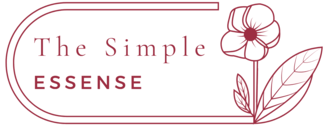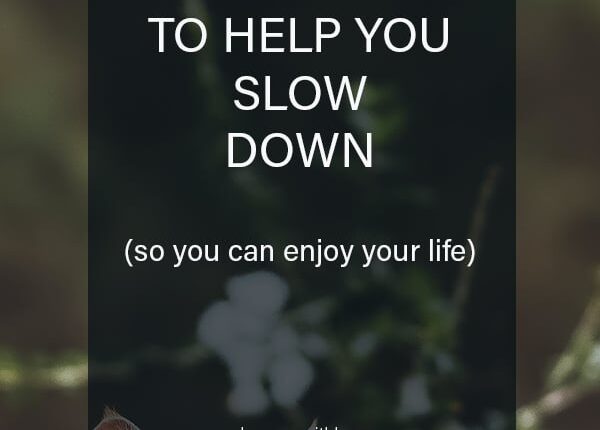How To Slow Down In Life
Before I began to simplify my life, I was on the go constantly. I didn’t feel like I had enough time to rest, pursue hobbies, or to hang out with friends. I never thought about how to slow down in life. My days were too busy, and my pace wasn’t sustainable.
Letting go of my “go, go, go” mindset took time. I began my adventures in slow living by changing my habits and setting boundaries. I did this very slowly because I wanted my habit changes and new boundaries, to stick. My strategy worked!
Slowing down the pace of my life has been invaluable. I’ve given myself the gift of time. I’m able to focus on creative projects, spend time with friends, rest, do nothing, and more. Going slow is a luxury that I’m incredibly grateful for.
What does it mean to “slow down”?
For me, slowing down is a combination of practicing mindfulness, getting enough rest, and prioritizing what matters in my life. When I find myself rushing from task to task, email to email, or from project to project, I return to Pico Iyer’s words. Iyer is one of my favorite authors because one facet of his work is about slowing down.
In Iyer’s 2014 TedTalk – The Art of Stillness – he said, “.. in an age of acceleration, nothing can be more exhilarating than going slow. And in an age of distraction, nothing is so luxurious as paying attention. And in an age of constant movement, nothing is so urgent as sitting still.”
The Importance of Slowing Down
Slowing down has offered me clarity and calm in a world that feels like it’s moving faster and faster. I don’t have to go on a month-long meditation retreat to reflect, rest, or to enjoy my daily life. Taking a few minutes out of my day or a few hours out of my week, helps me stay grounded and at ease.
3 key reasons to slow down
Reason #1: Slowing down will help you avoid unnecessary stress and burnout.
We live in a 24-7 economy; an economy that prioritizes consumption and work. Slowing down is one way to push back against the narrative that we need to be on the go all the time; especially at work.
As Sarah L. Jaffe wrote, “Work won’t love you back.” For instance, work offers me a sense of purpose and meaning. But work can’t meet all my needs. Setting strong boundaries in my professional life has helped me avoid undue stress and burnout.
Reason #2: Slowing down will give you the opportunity to take care of your physical and emotional health.
Studies have explored the benefits of creating a mindfulness practice like meditation. For example, mindfulness meditation is connected to health benefits like decreased anxiety, reduced blood pressure and stress, less depressive episodes, and more. This is true in my life. Taking the time to slow down–through meditation, breath work, or walking–has improved my physical and emotional health. It’s also made me happier!
Reason #3: Slowing down will help you prioritize what matters.
Deciding what to prioritize in life is a personal choice. I can’t tell you what to put first. I can say that slowing down has helped me:
- be attentive to my loved ones,
- make space for simple pleasures,
- focus on creative projects,
- reflect on the past and plan future goals,
- understand the difference between making a living and making a life,
- and so much more!
Lavinia Spalding wrote about the concept of “short sessions, many times” in her book Writing Away. I love this idea because it can be applied to activities like journaling or meditation.
For example, if my day is full, I build in short breaks to do nothing. My do-nothing sessions range from 2 to 10 minutes. When my days are more spacious, I have the option to build in longer breaks. Doing this helps me prioritize what matters.
If you found these reasons to slow down compelling and want to know more about how to slow down in life, here are 12 tips.
12 Tips for Slowing Down to Enjoy Life
Below are 12 practical ideas I’ve used to slow down. Incorporating these ideas into my life helped me let go of busyness, and enjoy simple pleasures like snuggling with my cat, a hot cup of coffee, phone calls with friends, and more. I hope these ideas help you, too!
- Turn off your phone. Turning off my phone is the easiest way for me to slow down and focus. This is better than Internet blocking apps because it’s so easy. I just have to press the off switch. I can instantly take a break from incoming text messages and the lure of the Internet. If you can’t turn off your phone, leave it in another room while you work, play, or rest.
- Delete your social media accounts, or use them sparingly. I broke up with social media in 2018 because I spent countless hours scrolling through photos and updates on various apps. This behavior didn’t make me happy. And yet, I kept scrolling! Deleting my accounts helped reclaim my time and it’s improved my mental health. Quitting social media might not be right for you. However, you can use social media sparingly (here are 15 tricks for spending less time on your phone). If you’re looking for more ideas about how to quit social media, check out Alexandra Franzen and Cal Newport’s work.
- Create a meaningful morning routine. After I quit social media, my morning routine became more relaxing and enjoyable. It’s a joy to wake up slowly, drink coffee, play with my cat, and chat with my husband. I also make time to write in my journal. I’ve noticed that what I consume first thing in the morning deeply impacts how my day unfolds. Social media and doom scrolling are out. More analog activities are in!
- Savor your coffee and tea. After I get out of bed in the morning, I make coffee. Then I sit on the couch and drink my favorite beverage. Usually my cat is on my lap. This is one of my favorite parts of the day because it’s so quiet. Savoring my coffee is especially sweet when it’s rainy and windy outside. It’s also an opportunity to make note of what I’m grateful for.
- Stop multitasking. Studies have shown that humans can’t multitask. We can single-task quickly, but research suggests this isn’t ideal. It leaves many people, including myself, feeling frenetic, unproductive, and unsatisfied. Now, I structure my day so that I can focus on one task at a time and do less. Gaining control over my work environment, and being able to single-task, makes me feel productive and accomplished.
- Simplify your to-do list. Before I start work, I write a long to-do list because writing the list helps me clear my mind. Then I prioritize what needs to get done. I look at my list and circle 3 or 4 tasks that I need to focus on. If I get the tasks done, I move onto the other items. At the end of the day, I usually feel like I accomplished something because my attention was focused instead of fragmented.
- Read a book. Reading is a great way to unwind and recharge; especially on blustery winter days. Recently, I spent a weekend with my family and it was stormy outside, so we sat by the fire and read all day. I felt like I spent two Saturdays reading! I love how time seems to stretch and expand when I read a good book.
- Take a walk. Walking is free, fun, and it’s an activity that helps me slow down. For example, I love walking in my neighborhood and in the local park. When I’m walking, I try to engage my senses. Paying attention to sights and sounds is an excellent way to let go of stress. I always carry a small journal with me so that I can record my observations. Reflecting on my notes at the end of the day is one way I practice gratitude.
- Write in your journal. When I journal about my worries, I’m able to start or restart my day with a little more clarity and ease. For example, Byron Katie’s work is helpful. Katie’s “Four Questions” enable me to reframe the stories I tell myself and become more mindful. Also, I love experimenting with how I use my diary. It’s a useful tool to reflect and slow down.
- Say “no” more often. When I was in my early twenties, I said “yes” to things that I didn’t enjoy doing because I wanted people to like me. Today, I say no frequently. Declining events, work projects, trips, and other things has given me perspective on life. It’s also given me time to do nothing or to pursue hobbies that I enjoy.
- Start a creative practice that helps you slow down. For over five years, I took a daily photo of my morning view. It was a fun creative project that helped me slow down, cope with grief, and savor simple pleasures like my morning cup of coffee. Beginning a daily creative project – like writing in your journal, drawing a quick sketch, or taking a photo – is an easy way to infuse creativity into your life. It’s also an opportunity to practice mindfulness.
- Find a community. Connecting with like-minded people who want to slow down is essential. Having a support network of friends who are interested in slowing down makes the journey more fun and meaningful. For example, I’ve found inspiration, and community connections, through books, podcasts, and educational programs. Making life changes is a little bit easier when you have a support network in place.
Here’s where you can start to slow life down…
Learning to master the art of slowing down is an ongoing adventure, and you don’t have to rush the process. Go at your own pace. As you learn to slow down, look for resources that support and inspire you.
Here’s a brief list of resources to get you started:
- Download the free Simplicity Quickstart Guide by Courtney Carver. It’s full of tips and tools that will help you simplify your life and slow down.
- Read 101 Ways to Adore Your Life This Year.
- Here are two helpful conversations about slowing down: The Urgency of Slowing Down with Pico Iyer and Sabbath and the Art of Rest with Judith Shulevitz.
And, here are a few inspiring books: Rest Is Resistance by Tricia Hersey, Bored and Brilliant by Manoush Zomorodi, and Four Thousand Weeks by Oliver Burkeman.

